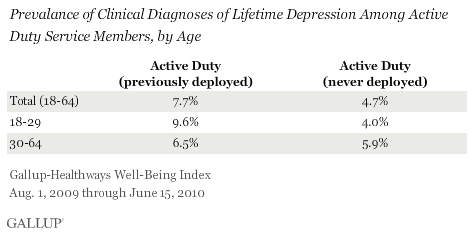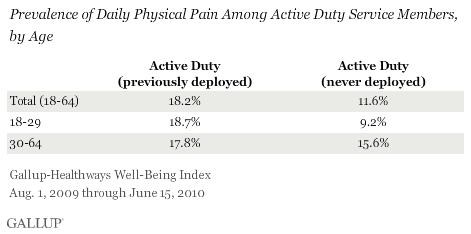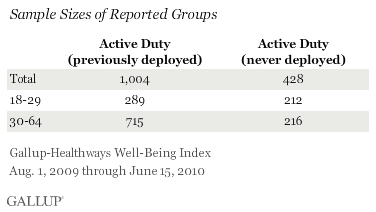This article is the third in a special multipart series on the well-being of the American military. covered active duty military and veteran well-being. looked at well-being among deployed versus non-deployed.
WASHINGTON, D.C. -- Active duty U.S. military personnel who have been deployed to a foreign war are more likely to have been diagnosed with depression at some point in their lives than those service members who have never deployed, with the largest percentage of diagnoses among those aged 18 to 29.

Among those 18- to 29-year-olds who've been deployed, 86% say they've served in either Iraq or Afghanistan, as have 80% of 30- to 64-year-olds. Still, the younger service members are far more likely than the older military personnel and more than twice as likely as their non-deployed counterparts to say they have ever been diagnosed with depression.
These findings are based on 1,432 interviews with active duty military personnel conducted Aug. 1, 2009 through June 15, 2010 as part of the . Among these respondents, all of whom were living in the U.S. at the time, 1,004 reported having been previously deployed to a foreign war, 818 of which were deployed to either Iraq or Afghanistan.
For more information on the Gallup-Healthways Well-Being Index, see page 2.
Daily Physical Pain Doubles for Young, Previously Deployed
Active duty military personnel who have been previously deployed are also more likely to report experiencing physical pain daily than those active duty service members who have never deployed. Again, the difference is more pronounced in the younger age group, with young military personnel who have returned from deployment showing a rate of chronic pain that is double the rate of their counterparts who have never deployed.

Even though they have experienced the difficulties of serving in a foreign war, previously deployed American military personnel under the age of 30 are still than U.S. workers as a whole (9.6% vs. 11.9%). Much of this difference, however, can be accounted for as a result of the disproportionately high percentage of male service members when compared with U.S. workers generally, as .
Still, the findings suggest that deployment to war can take an emotional and physical toll, especially for those under 30 as active duty personnel return state-side hampered with daily physical pain and depression diagnoses that are sharply higher than their non-deployed counterparts.
Learn more about the .
Survey Methods
Results are based on telephone interviews with 1,432 currently active U.S. military personnel, including 1,004 that have been deployed to a foreign war and 428 that have never been deployed. (The deployment status of the remainder is unknown.) Interviews were conducted with those aged 18 and older from Aug. 1 2009-June 15, 2010, as part of the Gallup-Healthways Well-Being Index. For results based on the total sample of national adults, one can say with 95% confidence that the maximum margin of sampling error is +3.0, +3.7, and +5.6 percentage points, respectively. Error ranges will climb higher for individual age groups within each category.

Questions used to discern military involvement and deployment to foreign wars include:
"Have you, or has any member of your household, ever served in the U.S. military?
Are you currently on active duty, or not?"
"Which war or wars, if any, have you been deployed to?"
Questions used to discern the clinical diagnosis of depression and daily physical pain include:
"Have you ever been told by a physician or nurse that you have depression?"
"Did you experience physical pain a lot of the day yesterday?"
Interviews are conducted with respondents on landline telephones (for respondents with a landline telephone) and cellular phones (for respondents who are cell phone only and cell phone "mostly").
In addition to sampling error, question wording and practical difficulties in conducting surveys can introduce error or bias into the findings of public opinion polls.
About the Gallup-Healthways Well-Being Index
The Gallup-Healthways Well-Being Index measures the daily pulse of U.S. well-being and provides best-in-class solutions for a healthier world. To learn more, please visit .
